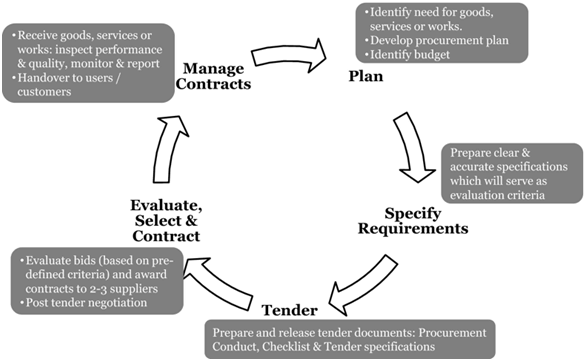The procurement department is responsible to acquire goods and services for a business. This may involve buying goods at competitive prices, handling all legal procedures required to place a contract, budgeting costs for the goods and monitoring financial trends to ensure that money is being spent wisely by the company
The pharmaceutical sector encompasses a variety of inherent issues from the view point of procurement. This includes long supply chains that starts in developing countries, specific legislation with regard to procurement. There is also the lack of transparency and access of information due to the marketing and proprietary nature of pharmaceuticals.
One of the key prerequisites for sustainable procurement of pharmaceuticals is to understand the way supply chains operates to enable risk assessments to be carried out prior to a specific procurement to allow for tenders to specify relevant requirements. The lack of transparency and the high degree of complexity in the pharmaceutical sector may jeopardize proper risk assessments to be carried out.
There must be clarity of requirements that include details about the rationale of requirements and where in the supply chain specific requirements have to be fulfilled. These are usually requested for from bidders, and thus puts demands on the pharmaceutical industry to provide more transparent information about its supply chains and its production processes.

Table of Contents
Two-Stage Tendering
In the two-stage process, the contractor becomes involved in the planning of the project at an earlier stage. The tenders are submitted on the basis of minimal information. In the second stage the employer’s team will develop the precise specification in conjunction with the preferred tenderer. This method is favored in more complex projects, where the contractor may have significant design input.
Open Tendering
Open tendering allows anyone to submit a tender to supply the goods or services that are required. Generally, an advert will be placed giving notice that the contract is being tendered, offering an equal opportunity to any organization to submit a tender. On larger projects, there may then be a pre-qualification process that produces a short-list of suitable suppliers from the respondents expressing interest in the contract. This short list will then be invited to prepare tenders. The selection of a short list can include pre-qualification questionnaires and interviews.
Open tendering is a slow and costly process, because the method attracts tenders or expressions of interest from large numbers of suppliers. Some suppliers may be entirely unsuitable for the contract and as a result it can waste a great deal of time, effort and money. However, open tendering offers the greatest competition and has the advantage of allowing new or emerging suppliers to try to secure work and so can facilitate greater innovation.
The number of firms tendering can be reduced (ideally to a maximum of six) by a pre-qualification process, and if this uses a standard pre-qualification questionnaire, then the time wasted by unsuccessful applicants can be minimized.
Restricted Tendering
The restricted tendering method only places a limit on the amount of request for tenders that can be sent by a supplier or service provider. Due to this selective process, restricted tendering is sometimes referred to as selective tendering. Like open tendering, restricted tendering is considered a competitive procurement method, however, the competition is limited to agencies that are invited by the procuring team. The procuring entity should establish a set of guidelines to use when selecting the suppliers and service providers that will be on the invitation list. Randomized selections will not bode well for procuring. This method is selective to find the best-suited and most qualified agencies to procure goods and services from. This method also enables the procuring team to save time and money during the selection process.

Request for Proposals (RFP)
Request for Proposal is a term that is used all across the business world. Social media managers receive RFP’s from potential clients all the time when a client is seeking a new manager of their venture. This kind of proposal is a compelling and unique document stating why the business is the best fit for the type of project at and. Similarly, in the procurement world, a RFP is a method used when suppliers or service providers are proposing their good or service to a procurement team for review. If you’re a supplier, understanding the ins and outs of quality service management is key to winning your bid. Read more about this in service quality management.
The full content is only visible to SIPMM members
Already a member? Please Login to continue reading.
References
Avinash Geerjammundo. (2012). “Industrial Buying in Pharmaceutical industry”. Retrieved from: https://www.slideshare.net/geerjamundo/industrial-buying-in-pharmaceutical-industry, accessed on 14/09/2019.
Brittani Sponaugle. (2014). ”6 Procurement Methods Obtaining Quality Goods and Services”. Retrieved from: https://blog.udemy.com/procurement-methods/, accessed on 14/09/2019.
Fabian Lee, DPSMM. (2017). “Effective Procurement Practices for Mass Consumption Products”. Retrieved from SIPMM: https://publication.sipmm.edu.sg/effective-procurement-practices-for-mass-consumption-products/, accessed on 14/09/2019.
Goh Chun Siang, DPSM. (2018). “Tendering Techniques for the Hotel Industry”. Retrieved from SIPMM: https://publication.sipmm.edu.sg/tendering-techniques-hotel-industry/, accessed on 14/09/2019.
Report 6735. (2016). “Procurement of pharmaceuticals in an environmental context and its inclusion into the CSR Compass”. Retrieved from: http://www.swedishepa.se/upload/miljoarbete-i-samhallet/miljoarbete-i-eu/Procurement-of-pharmaceuticals-in-an-environmental-context-and-its-inclusion-into-the-CSR-Compass-2016.pdf, accessed on 14/09/2019.
Siti Noridah Supaat, DPSM. (2019). “Essential Sustainable Practices for Procurement of Mineral Products”. Retrieved from SIPMM: https://publication.sipmm.edu.sg/essential-sustainable-practices-procurement-mineral-products/, accessed on 14/09/2019.

